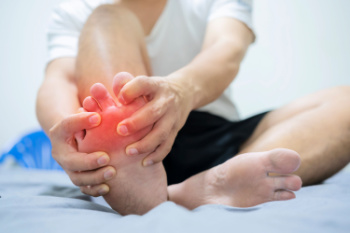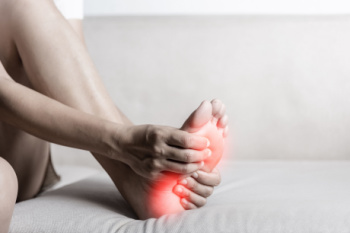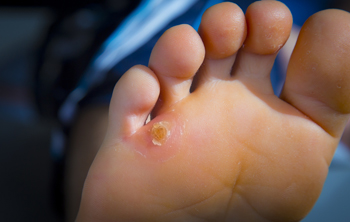Items filtered by date: March 2024
Arthritis Can Cause Pain in the Feet and Ankles
Foot Strengthening Exercises for Runners

In the world of running, the strength and flexibility of the feet often go unnoticed. From simple toe squish and toe splay exercises to deep squats and hip mobilization techniques, maintaining optimal foot function is essential for improving performance and avoiding injuries. These foot exercises not only strengthen the muscles and ligaments that support the arches, they also encourage proper alignment and biomechanics. Additionally, incorporating jumping exercises can enhance foot elasticity and running efficiency. Whether it's fine-tuning foot mechanics or overcoming injuries, a podiatrist's expertise can be indispensable for runners striving for peak performance and long-term foot health. It is suggested that you make an appointment with a podiatrist who can accurately diagnose any foot problems and offer treatment options to keep you running on the right path.
Exercising your feet regularly with the proper foot wear is a great way to prevent injuries and build strength. If you have any concerns about your feet, contact Jon McCreary, DPM from Fort Worth Podiatry. Our doctor can provide the care you need to keep you pain-free and on your feet.
Exercise for Your Feet
Exercise for your feet can help you gain strength, mobility and flexibility in your feet. They say that strengthening your feet can be just as rewarding as strengthening another part of the body. Your feet are very important, and we often forget about them in our daily tasks. But it is because of our feet that are we able to get going and do what we need to. For those of us fortunate enough to not have any foot problems, it is an important gesture to take care of them to ensure good health in the long run.
Some foot health exercises can include ankle pumps, tip-toeing, toe rises, lifting off the floor doing reps and sets, and flexing the toes. It is best to speak with Our doctor to determine an appropriate regimen for your needs. Everyone’s needs and bodies are different, and the activities required to maintain strength in the feet vary from individual to individual.
Once you get into a routine of doing regular exercise, you may notice a difference in your feet and how strong they may become.
If you have any questions please feel free to contact our office located in Fort Worth, TX . We offer the newest diagnostic and treatment technologies for all your foot and ankle needs.
What Is Ainhum and How Podiatrists Can Help?

Ainhum is a rare condition characterized by the spontaneous development of a constricting band around the base of the fifth toe. This can lead to progressive constriction, tissue loss, and eventual auto-amputation if left untreated. Podiatrists play a vital role in diagnosing and managing ainhum. They can provide early intervention by carefully monitoring the condition and relieving pressure on the affected toe. These foot doctors can offer treatments, such as surgical release of the constricting band or orthotic devices to alleviate discomfort and prevent further tissue damage. Podiatrists also can educate patients about proper foot care techniques and regular monitoring to detect any changes in the condition early on. If you notice a ring around one of your toes with a squeezing sensation, it is strongly suggested that you make an appointment with a podiatrist for a timely diagnosis and immediate treatment.
Some foot conditions may require additional professional care. If you have any concerns, contact Jon McCreary, DPM of Fort Worth Podiatry. Our doctor can provide the care you need to keep you pain-free and on your feet.
Rare Foot Conditions
The majority of foot conditions are common and can be treated by a podiatrist. Standard diagnostic procedures are generally used to identify specific conditions and treatment can be rendered. A podiatrist also treats rare foot conditions which can be difficult to diagnose and may need extra attention and care.
There are many rare foot conditions that can affect children. Some of these can include:
- Freiberg’s disease
- Kohler’s disease
- Maffucci syndrome
Freiberg’s disease - This can be seen as a deterioration and flattening of a metatarsal bone that exists in the ball of the foot. It typically affects pre-teen and teenage girls, but can affect anyone at any age. Symptoms that can accompany this can be swelling, stiffness, and the patient may limp.
Kohler’s disease - This often targets the bone in the arch of the foot and affects younger boys. It can lead to an interruption of the blood supply which ultimately can lead to bone deterioration. The patient may limp or experience tenderness, swelling, and redness.
Maffucci syndrome - This affects the long bones in a child’s foot leading to the development of abnormal bone lesions. They are benign growths and typically develop in early childhood and the bones may be susceptible to breaking.
A podiatrist can properly diagnose and treat all types of rare foot conditions. If your child is affected by any of these symptoms or conditions, please don’t hesitate to call our office so the correct treatment method can begin.
If you have any questions please feel free to contact our office located in Fort Worth, TX . We offer the newest diagnostic tools and technology to treat your foot and ankle needs.
Causes and Diagnosis of Foot Neuropathy

Foot neuropathy, a nerve disorder affecting the feet, can stem from various underlying causes. It presents with symptoms such as numbness, tingling, and pain. One primary cause of neuropathy is diabetes, which can lead to nerve damage over time due to high blood sugar levels. Other contributing factors include autoimmune diseases, infections, vitamin deficiencies, and traumatic injuries. To diagnose foot neuropathy, podiatrists typically begin with a thorough medical history and physical examination to assess symptoms and identify potential risk factors. Diagnostic tests such as nerve conduction studies and electromyography may be performed to evaluate nerve function and assess the extent of nerve damage. Additionally, blood tests may be conducted to check for underlying medical conditions contributing to neuropathy. Imaging studies such as MRI or CT scans may be utilized to rule out structural abnormalities or nerve compression. If you have numbness or tingling in your feet, it is suggested that you are under the care of a podiatrist who can help you to manage foot neuropathy.
Neuropathy
Neuropathy can be a potentially serious condition, especially if it is left undiagnosed. If you have any concerns that you may be experiencing nerve loss in your feet, consult with Jon McCreary, DPM from Fort Worth Podiatry. Our doctor will assess your condition and provide you with quality foot and ankle treatment for neuropathy.
What Is Neuropathy?
Neuropathy is a condition that leads to damage to the nerves in the body. Peripheral neuropathy, or neuropathy that affects your peripheral nervous system, usually occurs in the feet. Neuropathy can be triggered by a number of different causes. Such causes include diabetes, infections, cancers, disorders, and toxic substances.
Symptoms of Neuropathy Include:
- Numbness
- Sensation loss
- Prickling and tingling sensations
- Throbbing, freezing, burning pains
- Muscle weakness
Those with diabetes are at serious risk due to being unable to feel an ulcer on their feet. Diabetics usually also suffer from poor blood circulation. This can lead to the wound not healing, infections occurring, and the limb may have to be amputated.
Treatment
To treat neuropathy in the foot, podiatrists will first diagnose the cause of the neuropathy. Figuring out the underlying cause of the neuropathy will allow the podiatrist to prescribe the best treatment, whether it be caused by diabetes, toxic substance exposure, infection, etc. If the nerve has not died, then it’s possible that sensation may be able to return to the foot.
Pain medication may be issued for pain. Electrical nerve stimulation can be used to stimulate nerves. If the neuropathy is caused from pressure on the nerves, then surgery may be necessary.
If you have any questions, please feel free to contact our office located in Fort Worth, TX . We offer the newest diagnostic and treatment technologies for all your foot care needs.
Differences Between Calluses and Corns on the Feet
 Foot corns and calluses can have similar causes but are two different conditions often found on different parts of the feet. Both calluses and corns are areas of thickened skin caused by repeated friction or pressure. Calluses typically form on weight-bearing areas, like the soles of the feet, and are usually larger than corns. They are the skin's natural response to protect against excessive pressure. On the other hand, corns tend to be smaller and have a more concentrated core. They often develop on non-weight-bearing areas, such as the tops or sides of toes. Corns result also from friction or pressure, and ill-fitting shoes or toe deformities can contribute. While calluses and corns are generally harmless, they can become painful or problematic. If you suspect a corn or callus on your foot, it is suggested you seek diagnosis and treatment advice from a podiatrist.
Foot corns and calluses can have similar causes but are two different conditions often found on different parts of the feet. Both calluses and corns are areas of thickened skin caused by repeated friction or pressure. Calluses typically form on weight-bearing areas, like the soles of the feet, and are usually larger than corns. They are the skin's natural response to protect against excessive pressure. On the other hand, corns tend to be smaller and have a more concentrated core. They often develop on non-weight-bearing areas, such as the tops or sides of toes. Corns result also from friction or pressure, and ill-fitting shoes or toe deformities can contribute. While calluses and corns are generally harmless, they can become painful or problematic. If you suspect a corn or callus on your foot, it is suggested you seek diagnosis and treatment advice from a podiatrist.
If you have any concerns regarding your feet and ankles, contact Jon McCreary, DPM of Fort Worth Podiatry. Our doctor will treat your foot and ankle needs.
Corns: What Are They? and How Do You Get Rid of Them?
Corns can be described as areas of the skin that have thickened to the point of becoming painful or irritating. They are often layers and layers of the skin that have become dry and rough, and are normally smaller than calluses.
Ways to Prevent Corns
There are many ways to get rid of painful corns such as wearing:
- Well-fitting socks
- Comfortable shoes that are not tight around your foot
- Shoes that offer support
Treating Corns
Treatment of corns involves removing the dead skin that has built up in the specific area of the foot. Consult with Our doctor to determine the best treatment option for your case of corns.
If you have any questions please feel free to contact our office located in Fort Worth, TX . We offer the newest diagnostic and treatment technologies for all your foot and ankle needs.

